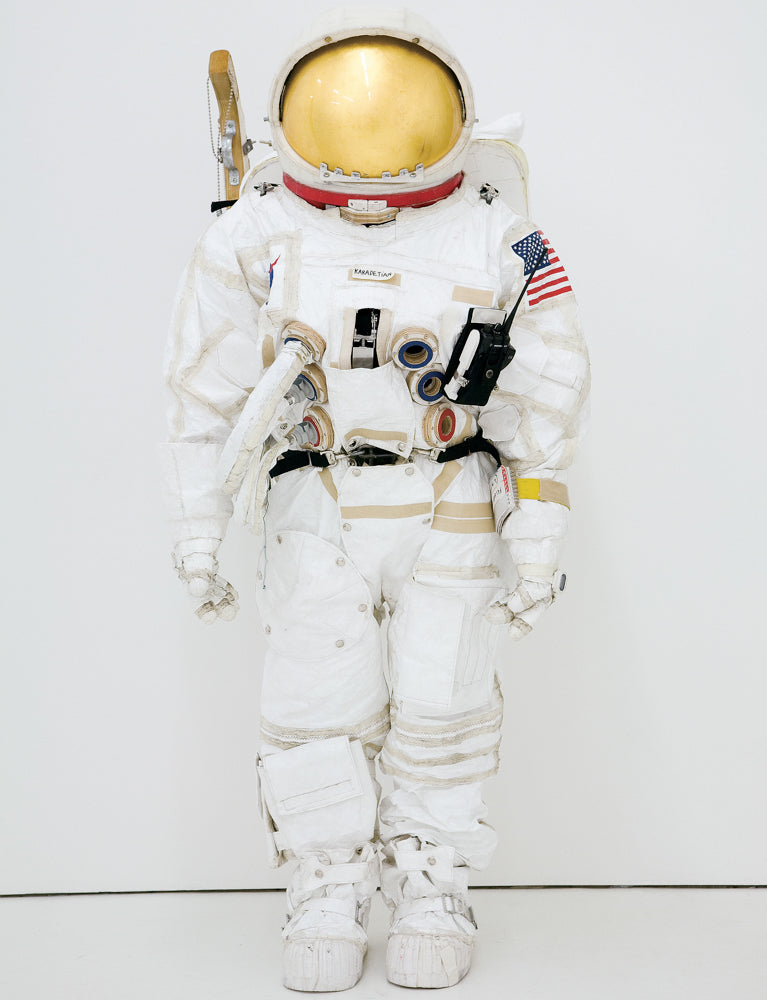
Ground Control To Tango Sierra
GROUND CONTROL TANGO SIERRA


A MISSION DEBRIEF WITH TOM SACHS
Framed by clear acetate Wayfarers and a mop of curly hair, the intensity of Tom Sachs’s gaze is matched only by the playful, almost boyish enthusiasm he exudes when discussing his art. Sitting down to talk about his epic ongoing project, “Space Program,” he references everything from his deep fascination with the Shaker movement to what he considers the most overlooked scene in Ron Howard’s blockbuster lunar mission thriller, Apollo 13.
Sachs is busy planning the third iteration of his “Space Program,” a “manned” expedition to Europa, the ice-encrusted sixth moon of Jupiter. His matter-of-fact delivery regarding such ambitions is no joke. Indeed, for the artist who once said, “going to the moon was the greatest art project of the twentieth-century,” the space race of the ’60s and ’ 70s was a grand, technological work of performance art, one that drew upon the dense constellation of patriotism and iconology reflective of America’s cultural attitude at the time. And while his projects are terrestrially bound—for now — it would seem that for Sachs, the final destination is not some extra-planetary touchdown, but rather illuminating the creative machinations required to get there.






Prior to “Space Program,” Sachs made a name for himself with works that mordantly and provocatively examined relationships between consumerism, capitalism, and production. Notoriously, in 1999, longtime NYC gallerist Mary Boone was arrested for exhibiting a Sachs piece — an Alvar Aalto vase filled with live 9mm rounds. In other works, such as his Chanel Chain Saw, 1996, Sachs built a mock chainsaw with boxes from the namesake Parisian fashion house. In a D.I.Y. creative process that he considers bricolage, Sachs looks to fashion new, often useable objects out of existing found materials, an approach that allows him to recast the quotidian within the context of the improbable. Excitedly recalling the scene from Apollo 13 in which a team of engineers is tasked with creating an air filter using only existing objects on the drifting lunar module, Sachs proclaims the event “one of the defining moments of the entire space program.”
For his 2007 show at the Los Angeles arm of art world powerhouse Gagosian Gallery, Sachs shifted his attention away from the world of conspicuous consumerism toward astronomical fantasy. Among other works included in the show, he had a full-size homemade version of the Apollo Lunar Excursion Module (LEM) constructed out of plywood. True to his bent for the comical, included in the lunar module was a fully stocked bar. During the exhibition, two female astronauts, fully clothed in space suits composed of tyvek, cotton polyester, and plywood air packs, took “samples” by drilling into the gallery’s concrete floor.



Sachs’s attention to detail and craft borders on the obsessive. But it is this totality and uniformity of vision that marks his projects as something other than a space nerd’s vision writ large. Indeed, speaking of his overall practice as an artist, Sachs told me that one of his guiding figures was Mother Ann Lee, founder of the Shaker religious movement. Led by a theological ethos toward production that mixes the spiritual with the material, Shakers believe that making things well and consistently is itself an act of prayer. For Sachs, such dedication and discipline of production extends to the rotating cast of assistants who work with the artist in his Soho studio.
For every new employee joining Sachs’s team, a ten-part film produced by the artist,Ten Bullets, is required viewing (tenbullets.com). While the delivery is tongue in cheek, the underlying message is more serious in tone; among the precepts the narrator of the instructional series intones, “Follow this guide carefully and you probably won’t be fired.”




In 2012, Sachs took over the 55,000-square-foot interior of the Park Avenue Armory for “Space Program 2.0: Mars,” the second installation of his “Space Program.” Several pieces from his earlier “Moon” project were stationed throughout the cavernous hall, among them his version of the LEM, now refitted for exploring Mars. In addition, a fully operational 1972 Winnebago Brave was transformed into a Mobile Quarantine Facility (MQF), replete with antennas and NASA logos. Elsewhere, amongst other structures, including a hydroponics laboratory, a teahouse stood constructed out of iconic Con Edison barriers. Every day throughout the exhibition, Sachs’s legion of crew members buzzed about the armory, whether on bicycle or skateboard, busily executing tasks and repairs associated with the mission — that is, when they weren’t drinking beer from a life-size Darth Vader fridge. No detail left to chance, all members of the Mars entourage were decked out in limited edition gear that the artist, collaborating with engineers from NASA’s Jet Propulsion Laboratory and NIKE, produced for the exhibition.
Whether whimsy or folly, Sachs’s creations probe themes that bring to the fore a very human aspect of the empirical age we live in today. Whether reproducing tools of exploration or restaging scenes of great technological accomplishment his works are uniquely personal — a reminder of the extraordinary relationship that exists between man and the devices he creates to understand the unknown world around him. “Scientists, like artists, are men of faith,” he says.















